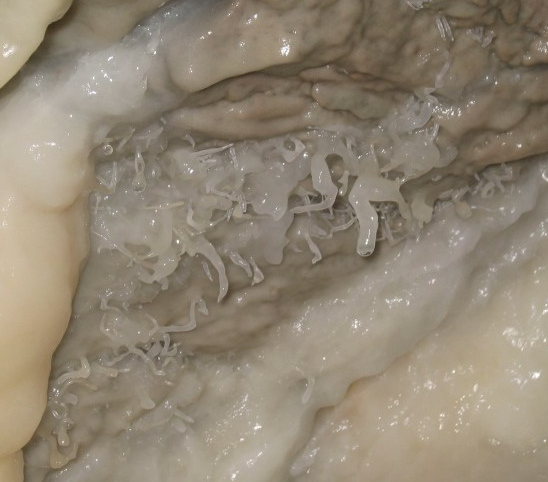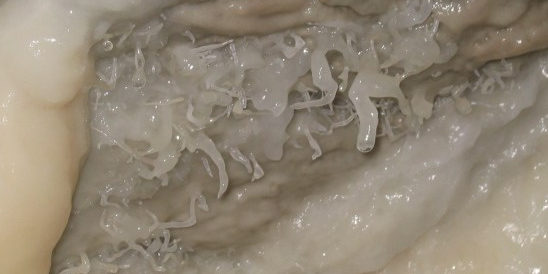
Helictites in the Tunnel of Paradise; in the centre a straw.
Stalactites usually always grow vertically; any eventual deviation of the growth axis can depend on dominating air currents which move the drop towards the direction of the wind, but that is uncommon, also because the direction of the air currents very often changes with the varying of the seasons. Given the extreme slowness of growth, the Winter phase gets compensated by the Summer one, and the result is always more or less that of a vertical stalactite.
When instead all the stalactites lean in the same direction that is due to the movement of air caused by the presence of large watercourses or where one or more waterfalls are nearby. The fact that in the Grotta del Vento the few stalactites out of axis are nearly always beside other ones which are vertical would make one think rather of some random abnormality of the growth, caused for example, by a blockage in the meatus for the water supply, following which the water finds an outlet laterally, to then assume again a vertical order.
In some parts however some unusual formations with a coral-like appearance can be seen, generally very slender and translucent, which seem to defy the laws of gravity growing in every direction in an apparently illogical manner with sharp deviations or ramifications. They don’t necessarily grow from the ceiling, but can start to grow on the surface of a vertical formation, sloping or sticking out, or, more rarely, on a rock face.
They are the so-called helictites, which, in fact have won the challenge, since their growth is not minimally linked to the force of gravity. As opposed to the straws, which have a meatus for water supply which has diametre of a little more than that a drop of water can assume at the moment it drips LE CANNULE, the helictites are fed from water coming from tiny channels (often less than a strand of hair) inside which the water circulates by capillarity, and the capillarity can happen in any direction, also upwards. The extremity of these tiny channels must allow a passage of water just sufficient enough to compensate the evaporation, extremely slow in an environment almost saturated with humidity. If due to an excess of flow this balance were to cease, at the bottom of the tiny channel a drop would form, giving way to the formation of a straw which would end the growth of the helictite.
These unusual limestone formations, made up of calcium carbonate (calcite), are generally grouped amongst themselves, forming unusual “bushes” which in the Grotta del Vento can only be found in the Tunnel of Paradise, off the touristic pathways.

Helictites in the Tunnel of Paradise.






